There are many types of pasta and everyone can choose what suits him or her the most. One of the popular types of pasta is a small, rice-shaped pasta known as orzo.
Orzo is made with semolina flour, which is made from durum wheat. Semolina flour has a higher protein content and that makes it more suitable for some people.
But, it is not gluten-free, so its usage is quite limited because a lot of people nowadays are intolerant to gluten.
So, if you are one of those people that do not have any orzo pasta on hand, or just want to try something new, below are 11 great orzo substitutes to consider.
Let’s take a look.
The List Of 7 Best Orzo Substitutes
I will start with the best orzo pasta alternatives in general. However, if you are in search of gluten-free options only, they are listed in the second part of the article. Now, let’s see what these substitutes have to offer.
1. Acini De Pepe

Like orzo pasta, acini de pepe is also made from semolina flour. The name “acini de pepe” actually means “peppercorns” in Italian, which describes the small, round shape of the pasta.
It is definitely one of the best alternatives to orzo pasta and you will soon learn why.
Pros:
• Texture: First, these two types of pasta have a similar texture, almost the same as orzo. When you cook orzo pasta, its texture becomes tender; and the same goes for acini de pepe.
• Availability: Acini de pepe pasta can be found in almost any grocery store. So, if you don’t have or can’t find orzo, go to your local grocery store and buy some acini de pepe pasta instead.
• Cooking Time: Finally, the cooking times of these two types of pasta are almost the same, so you can use acini de pepe as a substitute without having to adjust the cooking time of the recipe.
Cons:
• Size: Although similar in shape and size, acini de pepe is slightly smaller than orzo pasta, which makes it a bit different in terms of appearance. Also, this factor can influence the amount you’ll have to use in your dish.
• Flavor: Acini de pepe has a slightly different flavor, which can affect the final flavor of your dish.
• Liquid Absorption: Acini de pepe pasta tends to absorb less liquid, which means you will have to adjust the amount of liquid used in the dish.
How To Use Acini De Pepe:
Acini de pepe can be used in various recipes where orzo pasta is required.
Take note that acini de pepe is a bit smaller in size than orzo, so you will probably have to use it a bit more in the recipe.
Just like it is the case with orzo pasta, you will have to cook it in boiling water for about 10 minutes, if the package instructions don’t require something else, and you will have to drain and rinse it before using it in your recipe.
You can use acini de pepe pasta in soups, stews, salads, and casseroles.
2. Ditalini Pasta
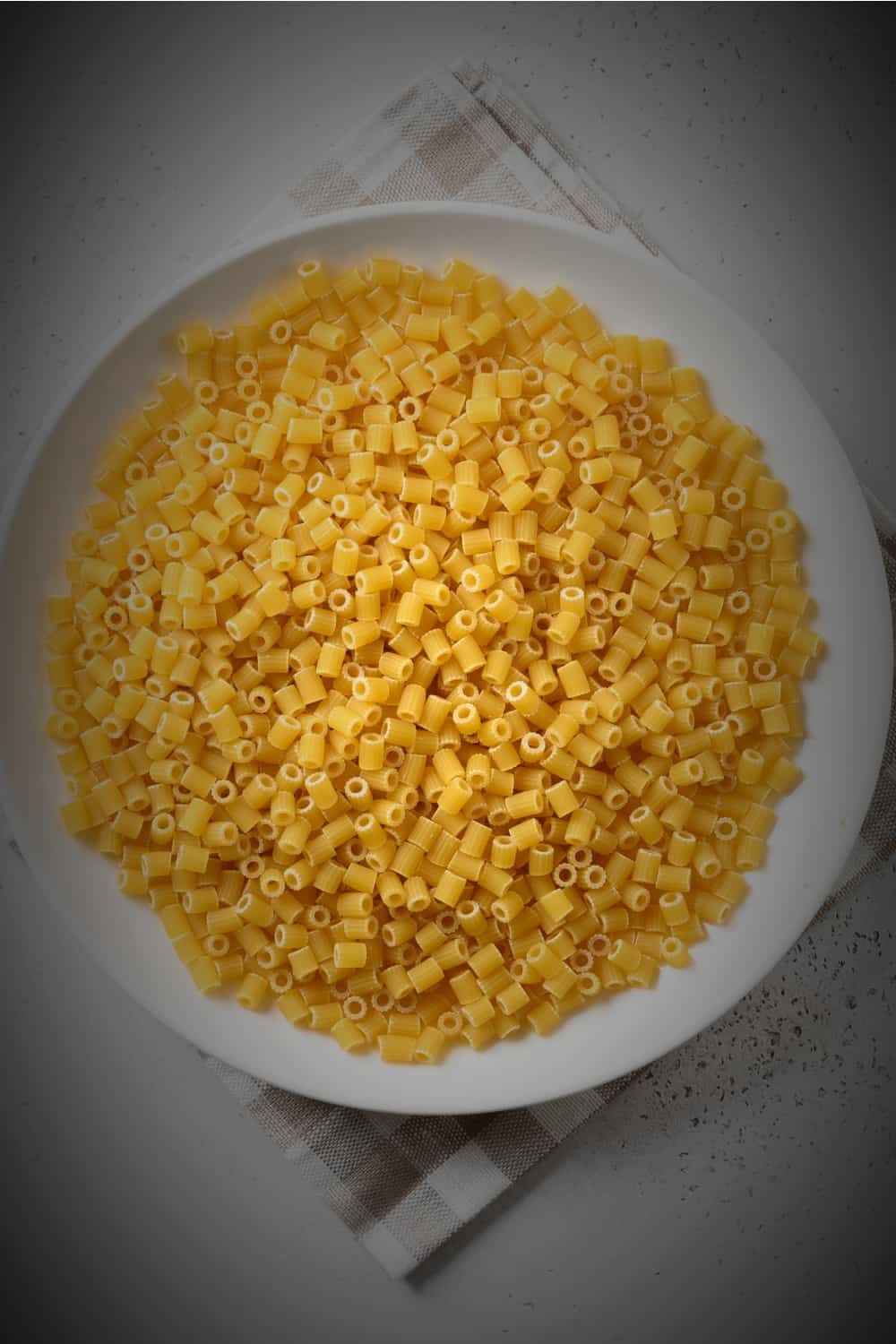
Also known as “tubettini pasta” or “little tubes”, ditalini pasta is one of the most popular types of pasta in Italian cuisine.
This type of food that starts with d is also small in size (which means it is considered “pastina” or “little pasta”), but it has a different shape, i.e. a tube shape.
Pros:
• Size: Ditalini pasta and orzo are similar in size. That means you don’t have to adjust the amount when using it as a substitute for orzo in your dish.
• Availability: Ditalini pasta is a highly available pasta and it can be found in many grocery stores and supermarkets in the US. If you, for some reason, can’t find it anywhere, you can always order it online.
• Affordable: Aside from the fact that it is readily available, ditalini pasta is also highly affordable and less expensive than orzo pasta. 1 pound of ditalini pasta (pack of 1) usually costs around $9.8.
Cons:
• Shape: Although both are small in size, these two types of pasta have different shapes that can lead to a different overall appearance of your dish. Namely, while orzo has a rice shape, ditalini is a tube.
• Texture: Ditalini and orzo pasta also have slightly different textures. Namely, ditalini pasta is shorter and thicker and its ridges can create a different mouthfeel when consuming a pasta dish.
• Cooking Time: The cooking times of these two kinds of pasta are not very different, but ditalini pasta has to be cooked a little longer. Namely, if you want to make it tender and suitable for consumption, you will have to cook it for 10-15 minutes.
How To Use Ditalini Pasta:
Ditalini pasta can be used in various recipes in place of orzo.
However, you have to take into consideration that ditalini pasta is slightly thicker, so it may not go well in recipes where the texture of the orzo is important.
Like orzo, you will have to cook it first (just a little longer i.e. about 10-15 minutes), drain it, and rinse it under cold water to stop the cooking process.
You can use it in various types of dishes like soups, stews, salads, and casseroles.
You can freely use a 1:1 ratio when substituting.
3. Stelline
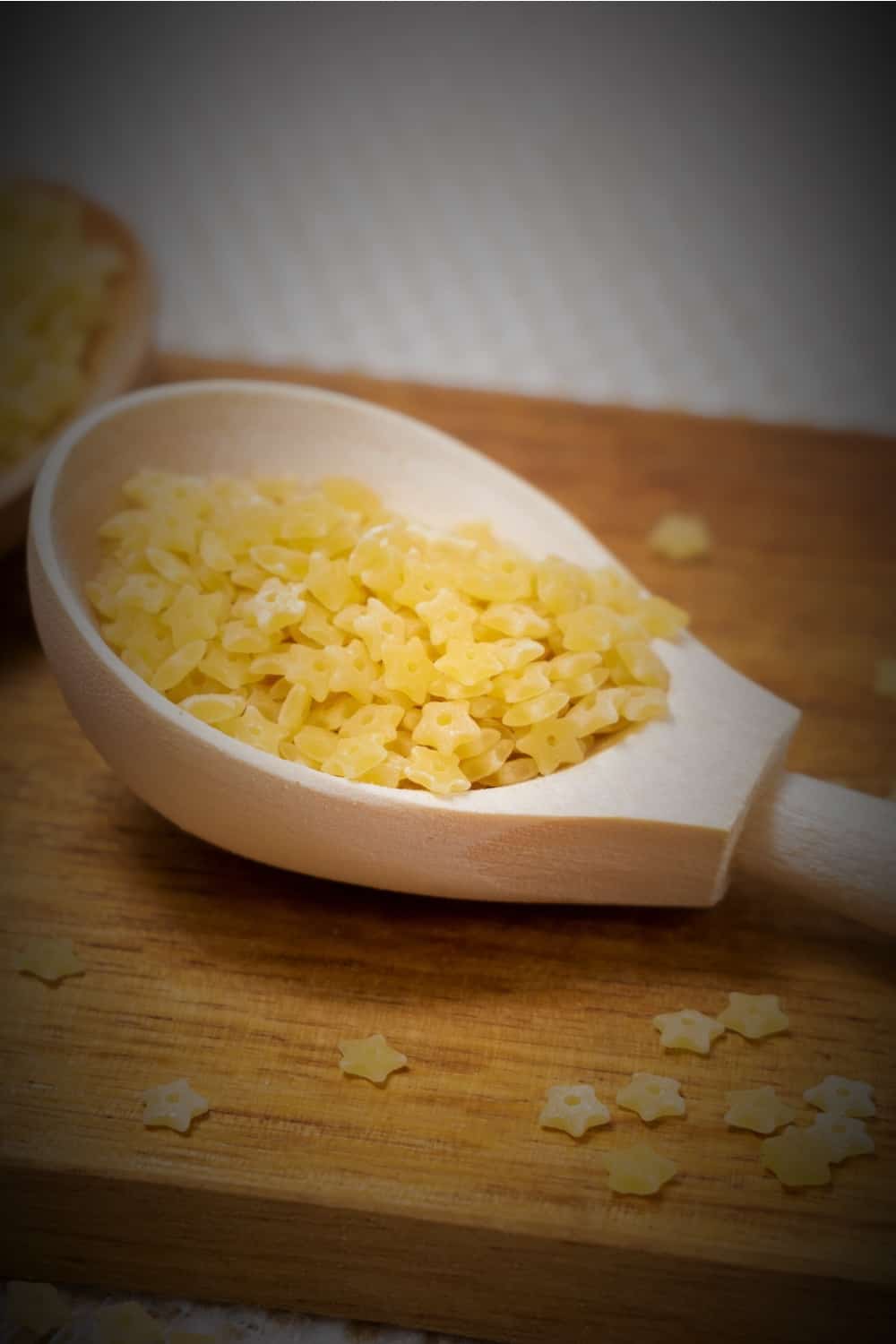
You probably remember those star-shaped pasta pieces from your favorite soup in childhood. Yes, stelline is pasta in the shape of stars and it is most popular as a main ingredient in soups.
It can also serve as an orzo substitute since it is made from semolina flour. However, it can also include some other ingredients like spinach and eggs for additional flavor and nutrition.
Pros:
• Size: If you are looking for small pieces of pasta, something similar to the size of orzo pasta, stelline is your best bet because it also has a small pasta shape.
• Flavor: Since both stelline pasta and orzo pasta are made from durum wheat semolina flour and water, they have almost the same taste.
Take note that stelline pasta can sometimes include some other ingredients as well, so it is not out of hand to take a look at the label.
• Availability: This type of pasta can be found in most grocery stores in the US, so it may be more accessible than orzo.
Cons:
• Shape: Many people, especially children, find the star shape of this pasta very appealing. However, when using it instead of orzo, which has a different rice shape, it can be a downfall because of more edges and points on the surface.
• Texture: Although both types of pasta become quite tender when cooked the right way, stelline pasta tends to be a bit more chewy and firm, so you should take that into consideration when using it as a substitute.
• Cooking Time: Orzo pasta cooks a bit longer than stelline, so you may have to monitor the cooking time and adjust accordingly.
How To Use Stelline Pasta:
It also has to be cooked in boiling water and drained before being served.
However, it doesn’t require that much to cook, i.e. 7-8 minutes is enough to cook it properly.
Also, since it has a different shape, it can not be added to all types of dishes considering the appearance of the dish. It is also slightly chewy and a bit firmer, so it is not an ideal pasta for those dishes where you want to achieve a creamy consistency.
All in all, it is one of the most popular ingredients in various types of soups, but it can also be added to salads, side dishes with sauces, as well as kid-friendly meals where the shape of the pasta is important.
Since the size is almost the same as orzo, you can use it in a 1:1 ratio.
4. Orecchiette
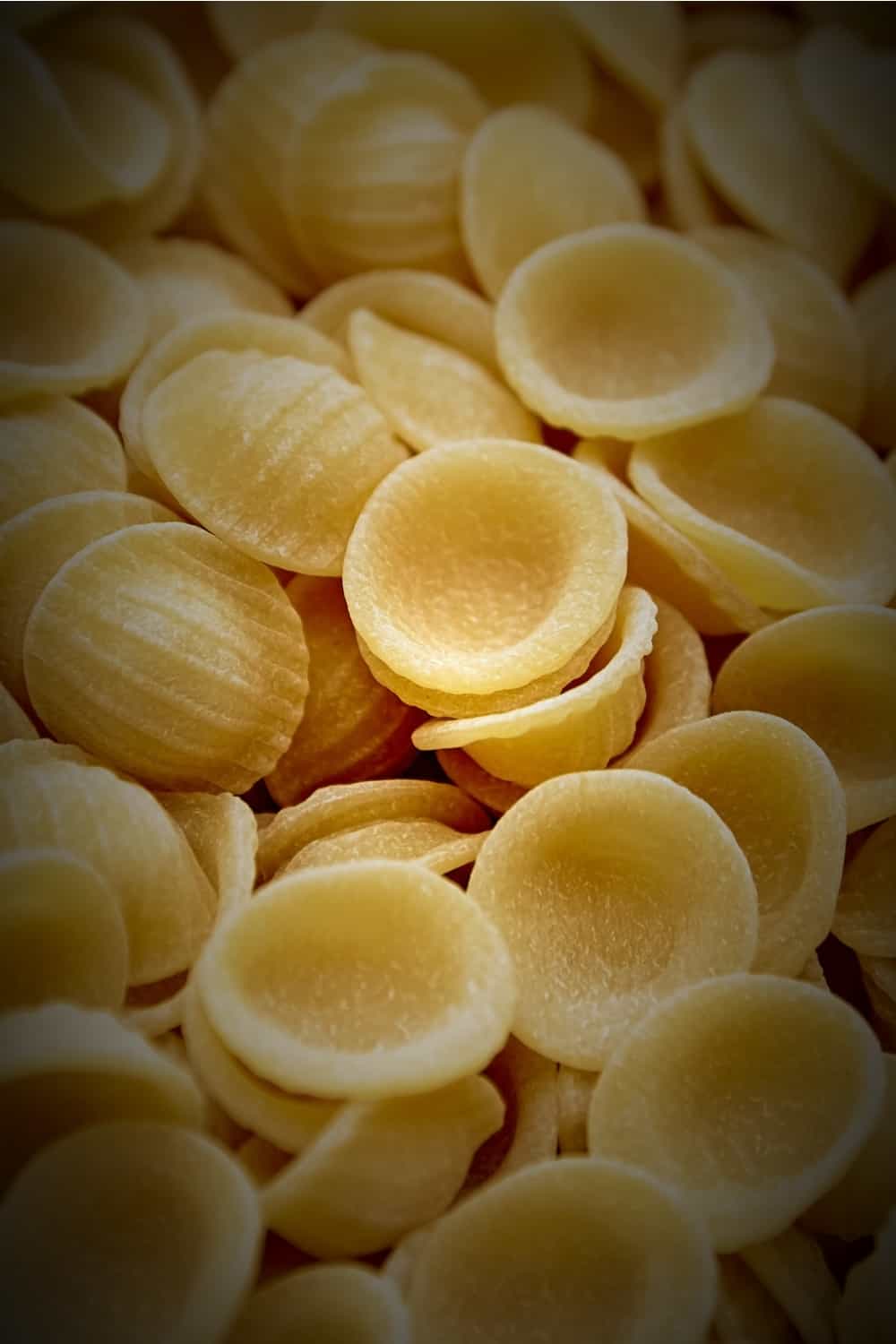
This type of pasta is mostly used in southern Italy, in Apulia. Translated to English, orecchiette actually means “little ears” and that is no surprise considering its shape.
Like orzo, it is also made from semolina flour, which makes it a decent orzo substitute.
Pros:
• Flavor: Both types of pasta are made from the same type of flour, which makes them similar in flavor. I just have to emphasize that some varieties of orecchiette pasta may have a slightly nutty flavor, compared to the more neutral flavor of orzo.
• Unique Texture: This type of pasta holds its shape well during cooking and has a slightly chewy texture, which can add a nice contrast to softer ingredients in your dish.
Cons:
• Shape: Orecchiette has a very different shape, i.e. it has the shape of a small dome, with its center thinner than its edge, and with a rough surface. That shape may not be very suitable in some dishes where appearance is important.
• Availability: Orecchiette pasta is not very common on the shelves of ordinary grocery stores in the US. If you truly want to incorporate it into your pasta dish, you may head for some Italian specialty food shops.
• Cooking Time: Finally, since it is thicker than orzo pasta, it may require a longer cooking time.
How To Use Orecchiette:
With its unique shape and similar flavor profile, orecchiette pasta can be a great orzo alternative in many dishes.
Their unique shape is great for holding sauces, but they also give a beautiful look to your dish. The texture is also quite unique, i.e. it is soft in the middle and chewy on the outside, so it is usually served with tomato sauce, meatballs, ricotta cheese, etc.
It is best to use it instead of orzo pasta in soups and salads because of its texture.
However, you should take note that it may take a bit longer to cook it (about 12-15 minutes) because it is thicker.
Also, you may have to use a smaller amount of it when substituting because it is bigger in size than orzo pasta.
5. Fregola
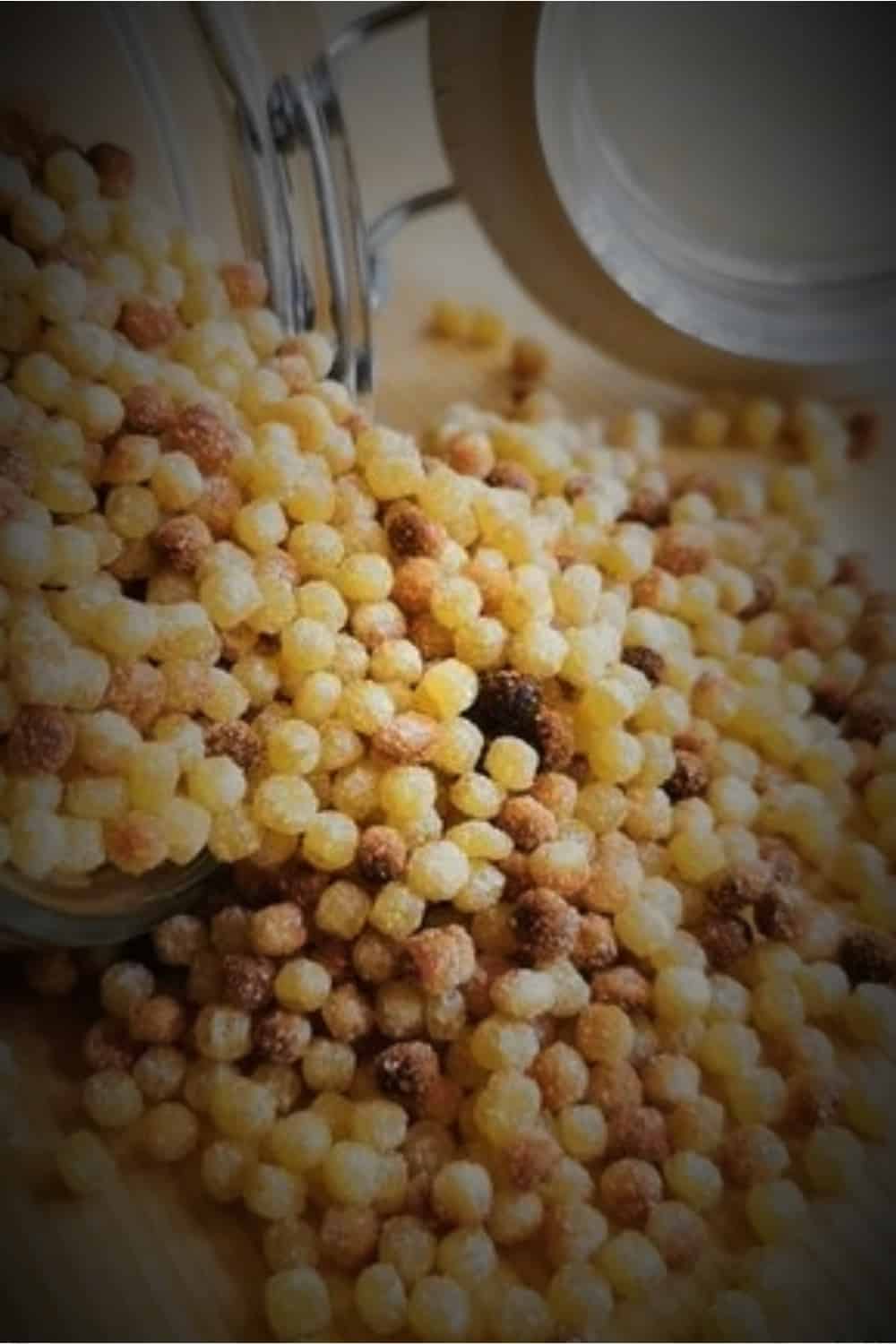
Also made from semolina and water, this spherical pasta comes from the Italian island of Sardinia and it is sometimes called Sardinian couscous because it lands somewhere between grain and pasta, somewhat similar to Israeli couscous.
This pasta can be a great alternative to orzo in many dishes, adding a toasted dimension to hot and cold side dishes.
Pros:
• Similar But Unique Flavor: Both types of pasta are made from the same semolina flour and that makes them similar in flavor. However, the flavor of fregola is more nutty, but that can be good for your dish’s flavor profile complexity and depth.
• Texture: Although it has a slightly chewy texture, fregola is still quite suitable as a substitute for orzo for all types of dishes where texture is important.
• Cooking Time: Both of these types of pasta require about 8-10 minutes for cooking. Fregola can sometimes be properly cooked even after just 7 minutes, but it won’t do any harm if you leave it on the stove for 1-2 minutes more.
Cons:
• Shape And Size: Although they have similar sizes, fregola is slightly bigger. When it comes to shape, fregola is rounded in shape while orzo has a rice-like shape and this can cause a different appearance of the final dish.
• Availability: Unless it is a very well-stocked grocery store, you probably won’t be able to find fregola in most grocery stores and supermarkets.
• Affordability: Fregola is also quite expensive, especially when compared with the cost of orzo pasta.
How To Use Fregola:
Fregola requires a similar cooking time and can provide your dish with a similar flavor and texture.
However, you should take into consideration that it has a slightly chewy texture, compared to orzo, so it is not a bad idea to cook it for a few extra minutes to achieve the desired texture.
Also, since it can provide your dish with an additional nutty flavor, consider adding it to those dishes that could benefit from it, like seafood or vegetable dishes.
In general, you can use fregola in a 1:1 ratio, but that really depends on the type of dish, as well as the instructions.
Finally, use fregola instead of orzo in soups, stews, and salads because it will reach its full potential there.
6. Couscous
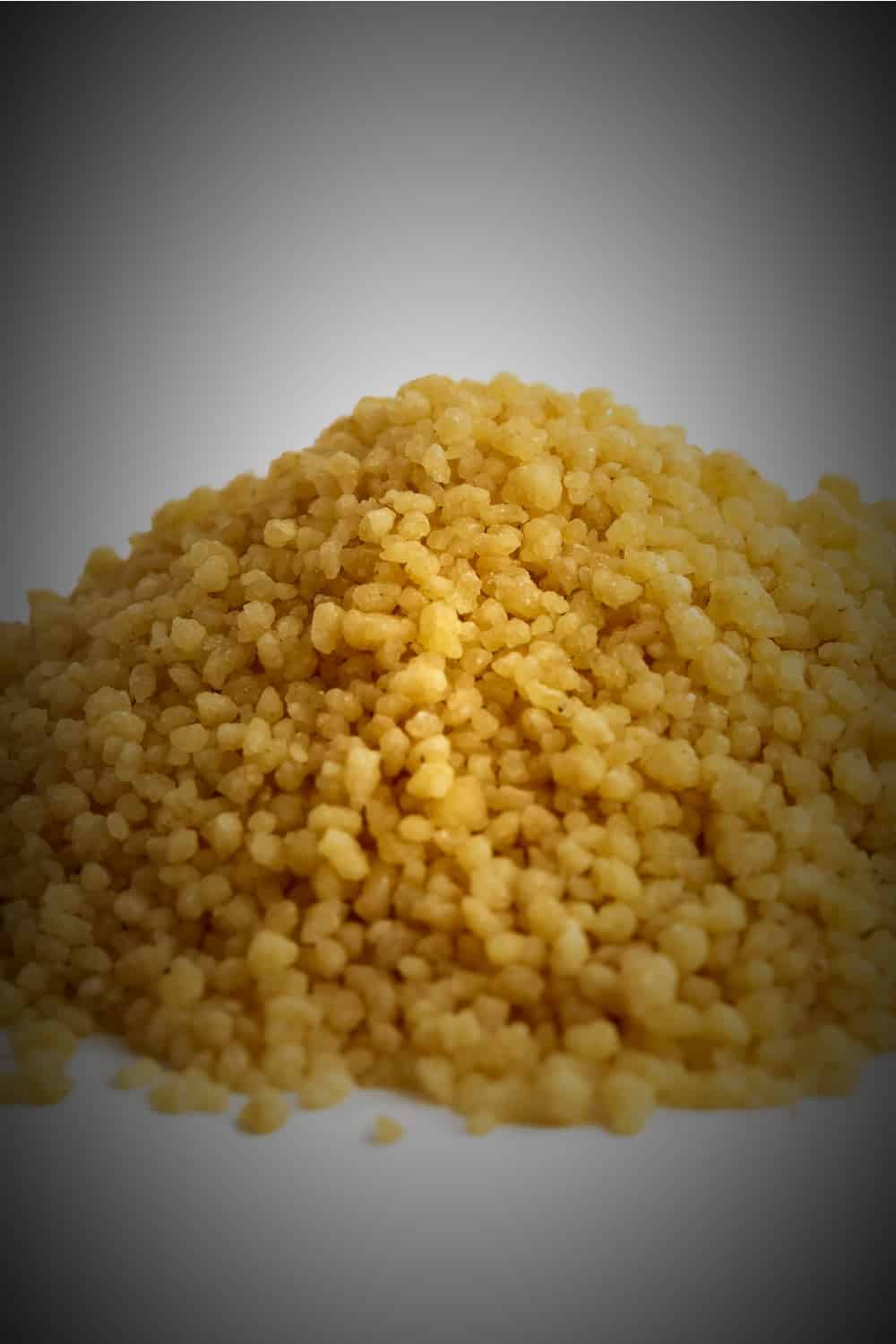
It is made from semolina flour as well and it is very tiny and looks like a grain, almost like orzo, but it is round in shape whereas the orzo looks more like an elongated grain. Aside from being a decent orzo substitute, it can also serve as an alternative to bulgur.
Pros:
• Texture: Couscous is chewy and firm in texture, but becomes tender and slightly chewy when cooked, almost similar to orzo pasta.
• Availability: Couscous can be easily found in most grocery stores and supermarkets and, therefore, you can easily buy it to replace orzo in your pasta dish.
• Quick Cooking Time: Because it is partially pre-cooked, orzo cooks in just about 5 minutes, making it one of the fastest pasta to cook.
Cons:
• Flavor: Couscous has a slightly nutty, sweet flavor and many people find that appealing. However, since orzo pasta has a somewhat neutral taste, couscous may not be suitable for some dishes where orzo is a main star.
• Shape And Size: Although there is not much of a difference, couscous is smaller than orzo and round in shape, and that can negatively influence the appearance of your dish.
How To Use Couscous:
In general, couscous can be cooked just like orzo, i.e. with water, as well as with some other ingredients like vegetable stock, olive oil, butter, and salt.
The only difference is the fact that 1 cup of couscous needs only about 1½ cups of water. Only if you prefer a softer and more tender texture, you can use a 1:2 ratio of couscous to water.
Couscous only needs about 5 minutes to cook and that is a great thing since it will save you a lot of time.
Couscous can be served as a side dish, usually with a meat or vegetable stew spooned over it.
It can be also used when making pasta salad like Mediterranean-style couscous salad with chopped veggies, olives, feta, and lemon vinaigrette.
7. Farro

It is an ancient grain, a grain “largely unchanged over the last several hundred years”. It is high in protein and fiber and also very nutritious. It is very similar to barley, another amazing grain most commonly used for making beer.
Farro can also be a decent alternative to orzo if you don’t have any or if you want a more healthy substitute.
Pros:
• Versatility: Farro is a quite versatile ingredient that can be used in many types of dishes, including soups, salads, and pilafs.
• Nutrition: Farro contains a lot of healthy nutrients, including protein, fiber, and some vitamins and minerals like vitamin B3, magnesium, zinc, and iron. It is also low in calories and fat, making it a healthier option.
Cons:
• Flavor: Unlike orzo which is somewhat neutral in flavor, farro has a distinctive nutty flavor that may not work very well in some recipes.
• Texture: Farro has a more chewy texture and that is not ideal for some dishes where the pasta is meant to be soft and creamy.
• Cooking Time: Unlike orzo which takes about 8-10 minutes to cook, farro is properly cooked only after about 20 minutes, which is double the time. Whole farro or semi-pearled farro can even take up to 40 minutes to cook.
How To Use Farro:
There are whole farro grains, semi-pearled, and pearled.
My suggestion is to use pearled variety because it takes less time to cook (15-20 minutes).
The process is not hard and it is similar to the process of cooking orzo pasta. All you have to do is to rinse the farro first and then cook it in a saucepan with boiling water until it’s tender enough.
The only difference lies in the fact that you have to add more water, i.e. for 1 cup of farro, you’ll have to add 3 cups of water.
You can use farro as an orzo substitute in salads, soups, casseroles, and risotto. It will enrich those dishes with specific nutty flavors and with a high nutritional value.
See Also: 10 Fantastic Farro Substitutes To Win The Grain Game
Let’s Not Forget Gluten-Free Alternatives To Orzo Pasta
Take a look at these gluten-free and nutritious substitutes for orzo pasta.
1. Millet

It is another type of grain that is quite nutritious, but this time, it is gluten-free as well.
It is a small, round, and yellowish grain that is part of the so-called grass family.
Millet has a mildly nutty flavor and slightly chewy texture. Honestly, that is not something like the texture and flavor of orzo pasta, but it can serve as a decent substitute in some recipes, mainly because it has a similar shape and size.
And of course, it is gluten-free and contains some important nutrients like niacin, beta-carotene, dietary fiber, potassium, and many other nutrients (1).
It can be used instead of orzo pasta in soups, stews, and salads.
2. Lentils

Plant-based meals are becoming more and more popular and lentils are the main stars there. They are a type of legume and are quite nutritious and, of course, gluten-free.
They are known for their high levels of protein and low levels of fat, making them suitable for lots of people, especially for those who are on a low-fat diet.
Studies have found that lentils may improve cholesterol levels in people with diabetes and may protect against breast cancer in women (2, 3).
Lentils have a similar shape and size to orzo pasta and that qualifies them for this list. However, the texture and flavor are not so similar.
The texture tends to be firmer when lentils are cooked and the flavor is somewhat earthy, as well as mildly peppery or sweet, depending on the type.
Lentils can be used in various types of dishes including salads, soups, stews, pasta dishes, pilafs, and casseroles.
3. Quinoa

Quinoa is an ancient South American pseudo-grain that comes from the Chenopodium quinoa plant.
It is becoming more and more popular all around the world and not without reason. It is full of various antioxidants and other nutrients like protein, fiber, and omega-3 fatty acids, meaning that it can provide you various health benefits.
Because of the similar small size and shape to orzo pasta, quinoa can be used in some recipes as an alternative. Those recipes include soups, salads, and pilafs.
You can use it in the same way as you would use orzo pasta. However, take note that it has a slightly different flavor and texture since it has a nutty undertone and earthy aftertaste, as well as a soft but slightly chewy texture when cooked.
I also have to emphasize that quinoa does not go bad so easily, i.e. it is quite shelf-stable, of course, if you store it correctly.
4. Cauliflower Rice

This amazing vegetable that starts with c is a versatile type of veggie that can be cooked in various ways and added to various types of dishes.
One of the forms of cauliflower is cauliflower rice. It is finely chopped cauliflower that can serve as a great substitute for ordinary rice which can be sometimes heavy in your dish because it contains starch.
Aside from that, it is gluten-free and it contains a lot of important nutrients like fiber, calcium, and potassium, as well as vitamins A and C.
You can use it as a substitute for orzo pasta in those dishes where the flavor and texture are not so important, such as in salads and casseroles.
You can also use it in the same way as you would use orzo pasta itself.
If you want to know how to make cauliflower rice at home, take a look at this video.
[sp_easyaccordion id=”4933″]


